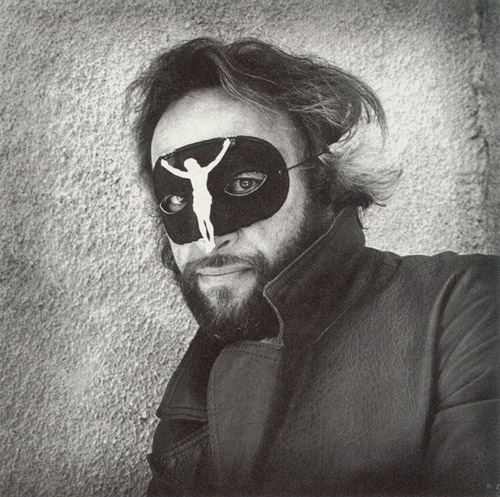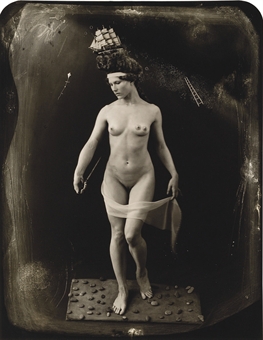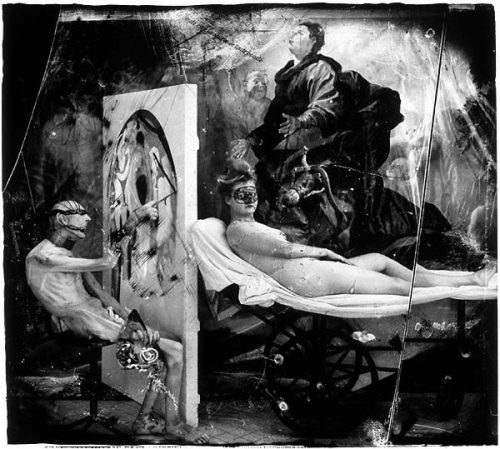Joel-Peter Witkin (born September 13, 1939, in Brooklyn, New York City) is an American photographer who lives in Albuquerque, New Mexico. His work often deals with such themes as death, corpses (and sometimes dismembered portions thereof), and various outsiders such as dwarves, transsexuals, hermaphrodites, and physically deformed people. Witkin's complex tableaux often recall religious episodes or classical paintings.
Beauty has three nipples
Influences and themes
Witkin claims that his vision and sensibility spring from an episode he witnessed as a young child, an automobile accident in front of his house in which a little girl was decapitated.
“ It happened on a Sunday when my mother was escorting my twin brother and me down the steps of the tenement where we lived. We were going to church. While walking down the hallway to the entrance of the building, we heard an incredible crash mixed with screaming and cries for help. The accident involved three cars, all with families in them. Somehow, in the confusion, I was no longer holding my mother's hand. At the place where I stood at the curb, I could see something rolling from one of the overturned cars. It stopped at the curb where I stood. It was the head of a little girl. I bent down to touch the face, to speak to it -- but before I could touch it someone carried me away". ”
He says his family's difficulties also influenced his work. His favorite artist is Giotto. His photographic techniques draw on early Daguerreotypes and on the work of E. J. Bellocq.
Poussin in Hell
Ars Moriendi
Techniques
Those of Witkin's works which use corpses have had to be created in Mexico in order to get around restrictive US laws. Because of the transgressive nature of the contents of his images, his works have been labelled exploitative and have sometimes shocked public opinion.
His techniques include scratching the negative, bleaching or toning the print, and using a hands-in-the-chemicals printing technique. This experimentation began after seeing a 19th-century ambrotype of a woman and her ex-lover who had been scratched from the frame.
Witkin begins each image by sketching his ideas on paper, perfecting every detail by arranging the scene before he gets into the studio to stage his elaborate tableaus. Once photographed, Witkin spends hours in the darkroom, scratching and piercing his negatives, transforming them into images that look made rather than taken. Through printing, Witkin reinterprets his original idea in a final act of adoration.
Madame X
Leda
Joel-Peter Witkin is a photographer whose images of the human condition are undeniably powerful. For more than twenty years he has pursued his interest in spirituality and how it impacts the physical world in which we exist.
Finding beauty within the grotesque, Witkin pursues this complex issue through people most often cast aside by society -- human spectacles including hermaphrodites, dwarfs, amputees, carcases, people with odd physical capabilities, fetishists and "any living myth... anyone bearing the wounds of Christ." His fascination with other people's physicality has inspired works that confront our sense of normalcy and decency, while constantly examining the teachings handed down through Christianity.
His constant reference to paintings from art history, including the works of Bosch, Goya, Velasquez, Miro, Botticelli and Picasso are testaments to his need to create a new history for himself. By using imagery and symbols from the past, Witkin celebrates our history while constantly redefining its present day context.
Visiting medical schools, morgues and insane asylums around the world, Witkin seeks out his collaborators, who, in the end, represent the numerous personas of the artist himself. The resulting photographs are haunting and beautiful, grotesque yet bold in their defiance a hideous beauty that is as compelling as it is taboo.
Joel-Peter Witkin lets us look into his created world, which is both frightening and fascinating, as he seeks to dismantle our preconceived notions about sexuality and physical beauty. Through his imagery, we gain a greater understanding about human difference and tolerance.
Documentary about his work may contain graphic or disturbing content.
Been aware of Witkin's work for a few years now and his work has made me view art and photography on whole new levels. Such as questions about the types of materials and processes we use to create art. Such as is the human form really an art material even after it has passed? Is it wrong to photograph people with deformities or abnormalities? Is it breaking respect or is making work about them a higher sign of it?
It was an old trade to photograph the dead called 'Memento Mori' and also not uncommon to photograph circus folk which gave them the public eye and a living. I felt he is an important photographer since he is pushing boundaries in the art world with technique and his subject matter. His use of symbolism in his work is all carefully planned out to the very last detail. Including the figures he asks to model for him and how he storyboards each piece before producing it. Also his extensive use of props which he collects or creates hims self to get the desired effect. I will be story boarding and collecting or creating props for my pieces for this project in a very similar way. Felt he was a strong example to research as a photographer and his themes or taboo subjects.



++Joel-Peter+Witkin.jpg)


No comments:
Post a Comment